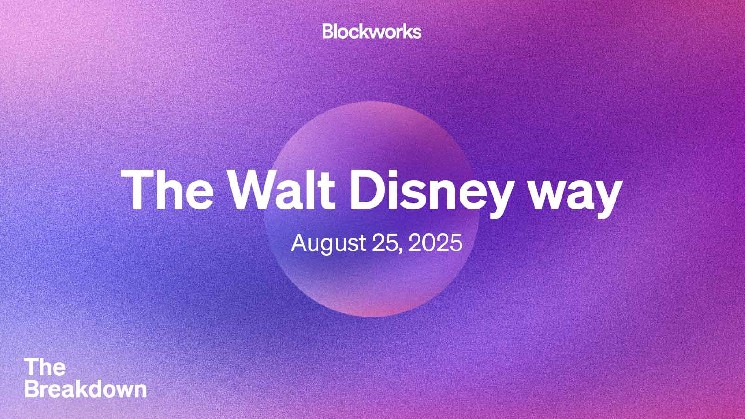This can be a section from The Breakdown publication. To learn extra editions, subscribe
“If you wish to know the true secret of Walt’s success, it’s that he by no means tried to become profitable.”
— Ward Kimball, Disney animator
Andrew Keys is an Ethereum OG whose credentials embrace attending the first-ever Ethereum meetup in 2014 and making ETH price greater than a greenback.
“The primary time Ethereum crossed $1 was as a result of I put a permissioned model of the Java consumer of Ethereum on prime of Azure,” he stated on the Empire podcast, “and we put out a 100-word press launch within the Wall Road Journal with Paul Vigna creating an idea of blockchain-as-a-service.”
Studying Vigna’s write-up from 2015 is a reminder of how little has modified within the 10 years since.
The narrative justifying $1 ETH was that Microsoft’s Azure would use Ethereum to “enhance operations from accounting to logistics to cross-border funds and settlement.”
It by no means actually occurred, however we’re now racing towards $5,000 ETH largely on the identical concept that Ethereum would be the company blockchain of alternative.
This stays speculative.
Ethereum generated $1.4 million of REV yesterday — greater than it did in 2015, in fact, however not so much relative to its $4,400 token worth and $531 billion market capitalization.
Keys, nonetheless, thinks that valuation is low as a result of Ethereum is underpricing its companies.
“On the expense of near-term profitability, the Ethereum Basis determined to make L1 blob area filth low-cost,” he defined. “I believe in time, the Ethereum group goes to say, ‘Nicely, that is too low-cost,’ and you may increase that pricing.”
Contemplate this the Uber idea of Ethereum’s worth: “As soon as Uber grew to become ubiquitous, they tripled costs,” Keys notes.
He expects Ethereum to do the identical: “As blockspace turns into extra aggressive, you possibly can increase costs.”
Uber is an excessive instance of a typical playbook for profit-maximizing companies, so I see why he cites it.
However layer-one blockchains aren’t companies — and I’m unsure they’re meant to be profit-maximizing.
As a substitute, I assumed the concept was to make blockspace as low-cost as doable (with out sacrificing decentralization), so we are able to get as a lot stuff onchain as doable.
If token holders become profitable within the course of as a result of the blocks refill and transactions get costly, that’s nice.
However making transactions costly simply so token holders make a revenue appears…not very crypto?
Layer-one crypto tokens do should have worth, largely to discourage spam and supply safety.
However, ideally, any extra worth would come from greater utilization, not greater costs.
And even when profitability had been the first aim, greater costs won’t be the best way to attain it.
As a future supply of income, Keys cites “blobspace” — an inexpensive, devoted lane on Ethereum for quickly making massive quantities of knowledge out there for anybody to validate.
However does blobspace have a moat?
“Making information out there” doesn’t sound just like the type of differentiated service that will have pricing energy — how laborious can or not it’s to retailer some information?
I’m guessing Keys would argue that Ethereum can have pricing energy due to its safety ensures, model and market capitalization.
However that is still speculative at this level and I’d counter that it’s simpler to begin a brand new blockchain than it’s a new riding-sharing service.
So I’m unsure Uber’s is one of the best enterprise mannequin for Ethereum to emulate.
The Walt Disney method
Ward Kimball attributed Walt Disney’s riches to by no means attempting to turn out to be wealthy: “If you wish to know the true secret of Walt’s success, it’s that he by no means tried to become profitable. He was at all times attempting to make one thing he might be pleased with.”
Disney informed his employees by no means to say prices to him — if one thing made a movie or his parks higher, he wished it in, regardless of the worth.
He constructed a zoo on the studio lot so animators might research animals whereas making Bambi. He insisted that the gargoyles on Disney World castles, too excessive up for anybody to see, be sculpted in full element.
For Disney, animation and theme parks had been ardour initiatives that he pursued towards all monetary recommendation, usually to the brink of chapter.
It labored out ultimately, in fact — which proves that typically, essentially the most profit-maximizing factor is to not maximize income.
In different instances, essentially the most profit-maximizing factor is to not make income in any respect.
Linus Torvalds, for instance, made his fortune by providing the Linux working system free of charge. Ceaselessly.
It’s simple to think about Torvalds would now be even wealthier if he charged even a couple of cents for using Linux — billions of units run on the software program he invented, from which he collects precisely $0.
However Linux grew to become a worldwide phenomenon exactly as a result of it was free to make use of and free to construct on — a freedom that turned customers into contributors.
Torvalds developed Linux with the assistance of hundreds of fans wanting to contribute to the open-source undertaking just because they believed in it.
With entry to the supply code, customers didn’t simply report bugs to Torvalds — they usually despatched him the repair, too.
Within the early days of its improvement, this allowed Torvalds to launch up to date Linux kernels as usually as day by day.
It’s unimaginable to think about Microsoft releasing new variations of Home windows day by day.
It’s equally unimaginable to think about that Linux might have been constructed every other method.
Immediately, Torvalds is variously estimated to be price between $50 and $150 million — a giant quantity, for certain. But additionally a tiny slice of the unmeasurable worth Linux has created for the world.
Nonetheless, a tiny slice of an enormous quantity is usually higher than an enormous slice of a small one.
If Torvalds had charged for Linux, his slice might need been 100% of nothing.
In contrast to Linux, Ethereum can’t be free — the chain received’t work except there’s a value to utilizing it.
However it doesn’t have to maximise income, both.









